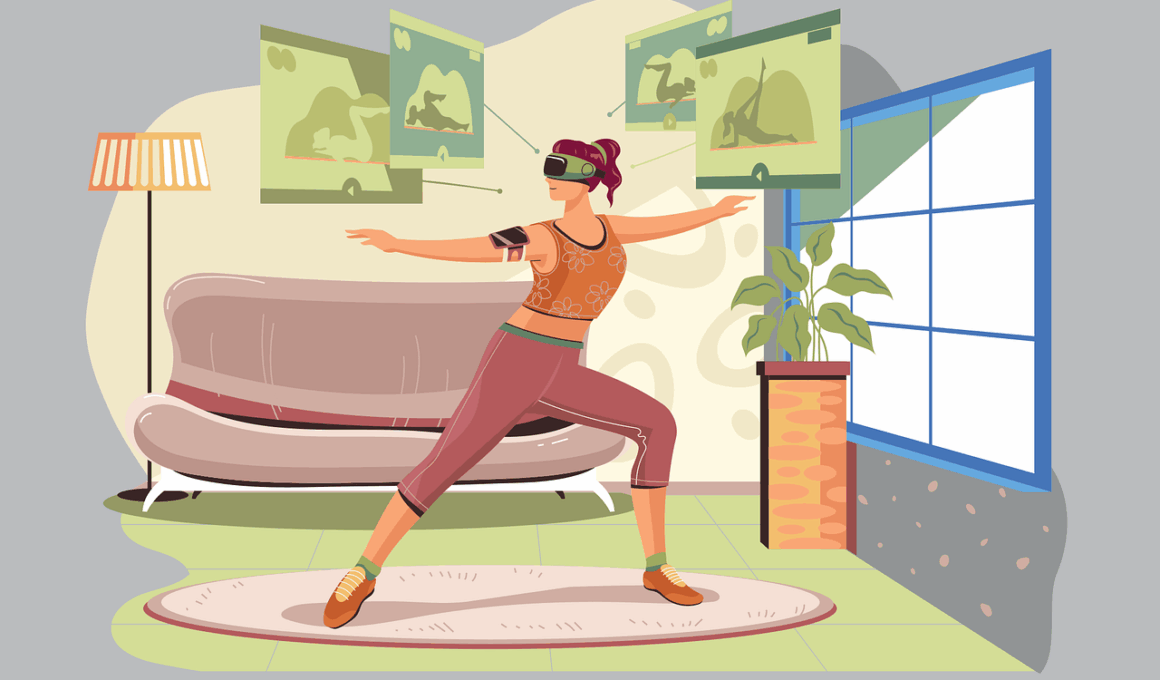Using Virtual Reality with Ellipticals for Enhanced Fitness
Virtual reality (VR) is revolutionizing modern fitness, especially for elliptical trainers. Traditional workouts can sometimes feel monotonous, leading to decreased motivation. However, incorporating VR into elliptical routines adds a layer of excitement and engagement. Users are transported into immersive environments, allowing them to virtually explore new terrains while exercising. Studies suggest that the combination of VR and fitness is beneficial for both mental and physical health. As users navigate through captivating landscapes, they can lose track of time. This distraction allows them to exercise longer and with more intensity than traditional workouts. Furthermore, VR can provide real-time feedback on user performance, helping individuals reach their fitness goals. This combination of technology and physical activity enhances not just physical fitness but also mental space. As VR technology continues to develop, the hardware and software specifically suited for fitness will further enhance the experience. These advancements lead to improved interfaces and capabilities, making workouts even more engaging and tailored. Therefore, users can look forward to a workout that fuses enjoyment with effective exercise. Through VR, elliptical workouts can become a futuristic experience that caters to diverse fitness levels.
The benefits of using VR with ellipticals extend beyond just entertainment. Research has shown that immersive experiences can significantly increase workout motivation and consistency. Users who engage with interactive elements during their workouts report higher levels of satisfaction. Integrating gamification elements can increase the challenges. For instance, users can compete against others in virtual environments, enhancing their competitive spirit and pushing them toward personal bests. Features that allow customization of workouts can cater to the user’s preferences as well. Individuals may have differing levels of expertise and fitness goals, therefore a tailored experience with VR equips users with suitable challenges. This creates engagement that is hard to achieve in a standard workout. Additionally, by hitting personal bests within a virtual format, users are more encouraged to continue their routine, thereby enhancing overall cardiovascular health. The data collected during these workouts can be analyzed to help refine future sessions. Tailored routines can target specific muscle groups and fitness goals based on user performance. As such, this adapts the workout to suit individual needs, ultimately leading to improved health outcomes. Hence, the future of fitness may be dominated by such advancements in technology.
Improving Workout Experience
Improving the workout experience is pivotal for maintaining fitness. Virtual reality introduces elements such as environments, challenges, and rewards. Users can cycle through serene beaches or climb steep mountains, stimulating scenic experiences that motivate prolonged activity. Engaging multiple senses creates a captivating environment that enhances focus and enjoyment. This transformation from a mundane session to a exciting adventure allows for higher output during workouts. Participants often find they are pushing harder and maintaining focus longer. This shift results in better calorie burning and heightened cardiovascular benefits. Moreover, VR can help in developing skills that enhance real-world athletic performance. Using ellipticals with VR enables users to simulate various terrains, effectively improving their overall fitness. These experiences can replicate real-life scenarios, preparing users for outdoor activities, running events, or cycling races. Additional virtual competitions with friends or global participants add motivation to excel. Hence, this gamification aspect encourages healthy competition and community engagement. Participants are likely to share experiences as they enhance their skills within the virtual environment. Consequently, many find themselves forming networks and friendships based on fitness, fostering accountability and community spirit.
Moreover, the mental health aspect of VR workouts should not be overlooked. Engaging in immersive environments can significantly help alleviate stress and anxiety. Individuals may experience cathartic benefits when physically active in a setting that feels novel and stimulating. This potential for enhanced well-being is reinforced by the ability to escape into a virtual world when reality becomes overwhelming. As users break from their daily routines, they can explore exhilarating terrains while gripping the handles of an elliptical trainer. This distraction from outside stressors can lead to a more focused workout, as users experience moods uplifted by their surroundings. With consistent engagement, marked improvements in both physical and mental health can be achieved. Regular activities lead to better endorphin releases, contributing to a generally positive state of mind. Furthermore, the sense of control in virtual environments offers a sense of empowerment, especially for individuals who may struggle with self-image issues. Thus, improving mental health alongside physical fitness creates a holistic workout experience. With growing recognition of the importance of mental health, VR in fitness emerges as a formidable ally. This empowers users towards achieving comprehensive well-being alongside physical improvements.
The Future of Fitness Technology
As technology continues evolving, the future of fitness appears both exciting and unpredictable. VR technology is likely to expand its reach, making workouts even more personalized. Innovations in tracking personal health metrics and performance can enhance the workout quality further. As manufacturers strive to combine seamless connectivity with ellipticals, opportunities will arise to cater directly to fitness goals and preferences effortlessly. This connectivity can offer users a unified health hub that relays varied data from workouts. Combining these signals with advanced algorithms could result in predictive analytics, guiding users in reaching their targets efficiently. Furthermore, options for virtual trainers or instructors may emerge, allowing individuals to follow personalized plans effectively. Virtual trainers can provide motivation, techniques, and feedback, all while observing the user’s performance in real-time. The additional dynamics offered by intelligent coaches can further personalize the workload. This ensures adherence to best practices while minimizing risks of injuries. Enhanced safety features combined with real-time feedback contribute to an overall better training experience. As the convergence of VR in fitness continues, users await even more groundbreaking innovations. Keeping pace with these changes will determine how fitness evolves over the next several years.
Another consideration of merging VR with ellipticals is the affordability of technology. As virtual reality evolves, costs are expected to decline, making VR-equipped ellipticals widely accessible. Increased adoption could catalyze a greater understanding of fitness technology among users. This level of understanding translates into enhanced user engagement and healthier lifestyles, as more individuals explore interactive fitness solutions. Moreover, commercial fitness centers may increasingly invest in VR training equipment, providing users access to cutting-edge technology. Creating community spaces around these immersive experiences promotes group classes and integrations that enhance fitness environments. With larger scale adoption, creators will generate value-making VR experiences on ellipticals, driving innovation. Enhanced competition stimulates continued growth in the sector, resulting in more multifaceted offerings for fitness enthusiasts. Meanwhile, fitness tech creators will refine the hardware and software as demand increases, creating systems unmatched by traditional trainers. Hence, affordability plays a significant role in the democratization of fitness through technology. The future may hold countless possibilities for how ellipticals and VR converge, ultimately reshaping fitness industry foundations. Adapting to these trends will become essential for users eager to embrace the vanguard of fitness solutions.
Conclusion
In conclusion, incorporating virtual reality with elliptical trainers opens unlimited possibilities for modern fitness experiences. The multifaceted advantages span enhanced engagement, improved motivation, and impeccable data analysis. With VR, users provide immersive environments that combine entertainment with challenging workouts, contributing to better health outcomes. These experiences transcend standard exercising, creating an engaging atmosphere that encourages users to break barriers. The potential insights derived from integrating this technology guide users towards achieving personal fitness goals in unprecedented ways. Moreover, mental well-being benefits act as a crucial complement to physical fitness enhancements. As technology continues to evolve, so too do the opportunities for fitness enthusiasts to access innovative solutions. Users can anticipate advanced features emerging, from real-time performance feedback to personalized coaching. As VR becomes more affordable, accessibility rises, ensuring wider participation in transformed fitness dynamics. Gyms and fitness centers will adapt along with these advancements, creating communities benefiting from collective efforts towards health. Ultimately, the future of fitness remains bright as virtual and physical realms blur together. Innovations and insights will forever change how we view exercise, fitness, and overall wellness. With the fusion of VR and ellipticals, exciting times are ahead for all fitness enthusiasts.
This transition period toward high-tech fitness encourages everyone to embrace an evolving lifestyle. By welcoming virtual experiences, users will redefine their workouts and personal health journeys. As realism in simulated environments continues to improve, exercise becomes less like a chore and more an enjoyable adventure. With VR, daily routines transform, making challenges seamlessly integrated. Ultimately, the scenarios we step into during these workouts showcase the impact of imagination within the larger fabric of our lives. VR unlocks the door to holistic engagement with fitness, a realm previously unexplored. Users prioritize unique experiences as technology advances, setting new goals along the continuum of wellness and vitality. All elements combined signal an exciting direction for the fitness narrative. Users can look forward to a future where immersive environments redefine how we perceive exercise, health, and community. Together, maintain a strong focus on innovation and adaptability. This embracing of fitness technology ensures that accessibility stands at the forefront. As individuals embark on their fitness journeys, the collaboration between virtual worlds and real workouts becomes a more available aspect. The ongoing excitement within this evolving landscape promises dynamic experiences and substantial health improvements for all.


